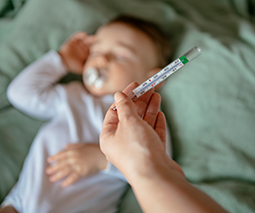Everything you need to know about immunising your baby

Australia’s vaccine schedule starts the day your baby is born. It’s simple, straightforward, and it could save your baby’s life. Here are some of the key facts to know about immunising your baby in their first 12 months.
Why vaccinate?
Dig around the internet, and you can find so much conflicting information about immunisation. It can be confusing, but the facts are real: childhood immunisation protects our babies from potentially life threatening diseases. It’s scientifically proven to be safe and effective, and it’s our strongest line of defence against dangerous and contagious diseases such as measles.
But here’s the critical thing – not all vaccinated people develop protective immunity, so the vaccines are most effective when the majority of the population has been vaccinated. It’s known as herd immunity. If enough people are immunised and protected from a disease, the infection can’t spread. This in turn protects the population as a whole, including those who can’t receive all their vaccinations, such as very young children, people with immune system problems and the critically ill. For Australia to reach herd immunity, we need 95 per cent of the population to be immunised.
There are even free vaccines available to some segments of the community who have been identified as being more at risk for some infectious diseases. If your baby identifies as Aboriginal or Torres Strait Islander, they should have a free annual influenza vaccine each year, starting from six months of age. If your baby was born with a low birth weight or has a serious health condition, they may be eligible for other free vaccines under the immunisation schedule, so speak with your GP.
When you keep your baby up to date with their vaccinations, you’re not only protecting your child’s health, you’re also caring for the entire community.
Birth to 12 months: the essential vaccines
There are five rounds of vaccines your baby will need in their first 12 months. While some doctors and health care providers may charge you for a consultation, all of the following vaccines listed under the National Immunisation Program are free. Here’s a basic rundown of the vaccine schedule in your baby’s first year:
Birth
- Hepatitis B
2 months
- Hepatitis B – diphtheria – tetanus – pertussis (whooping cough) – Haemophilus influenzae type b – poliomyelitis (polio)
- Pneumococcal
- Rotavirus
4 months
- Hepatitis B – diphtheria – tetanus – pertussis (whooping cough) – Haemophilus influenzae type b – poliomyelitis (polio)
- Pneumococcal
- Rotavirus
6 months
- Hepatitis B – diphtheria – tetanus – pertussis (whooping cough) – Haemophilus influenzae type b – poliomyelitis (polio)
- Pneumococcal
- Rotavirus
12 months
- Haemophilus influenzae type b – meningococcal C
- Measles, mumps and rubella
What’s in a vaccine?
According to the federal government’s Immunise Australia Program, vaccines contain small doses of either:
-
-
- a live but weakened virus;
- a killed bacteria or virus, or small parts of bacteria; or
- a modified toxin produced by bacteria.
-
They may also contain a small amount of preservative, or an antibiotic to preserve the vaccine. Vaccines available on Australia’s National Immunisation Program have not contained thiomersal (mercury) since 2000.
How are the vaccines administered?
Most infant immunisations are given as an injection in the leg, except rotavirus vaccine, which is administered by mouth. A vaccination dose may contain a vaccine against one specific disease. Sometimes vaccines are combined in the same injection to provide immunity for several diseases.
You can take your baby to the local GP for their vaccines. Local councils and health clinics also offer immunisation services.
How long until it takes effect?
It takes roughly two weeks for the normal immune system to respond to vaccines. However some vaccines need to be administered multiple times to build up the required protection, such as diphtheria-tetanus-pertussis.
Are there side effects?
You might notice some very minor side effects in your baby after their immunisation, such as soreness, swelling at the site of the injection, unsettled behaviour or a light fever. These usually only last a short time. There are some very rare reactions to immunisation, such as febrile seizures. Be sure to contact your doctor immediately if you notice anything unusual.
What happens if you miss a vaccination?
The Australian Immunisation Register captures all National Immunisation Program vaccines, given to people of all ages. If you’re ever in doubt of where your baby is up to, contact the register and they can provide you with a copy of your child’s immunisation history on request.
If you are behind with your baby’s immunisation schedule, don’t worry – simply talk to your doctor or immunisation provider as soon as possible, and they will help organise a ‘catch-up’ immunisation for your baby.
How to prepare for your baby’s vaccinations
When vaccination day rolls around, bring along your Medicare card and child health book to your appointment. If you’re feeling a bit nervous, you might also want to bring your partner or a family member for support.
Dress your baby in loose, comfortable clothes. You could also pack any comfort items, like a dummy or blankie, to help soothe them after their injection. Many babies will also be comforted by a feed, so just prepare for a quick breast- or bottle-feed after the appointment.
Remember, you’re doing a great thing for your baby.
(This is a sponsored post for the Victorian State Government)








